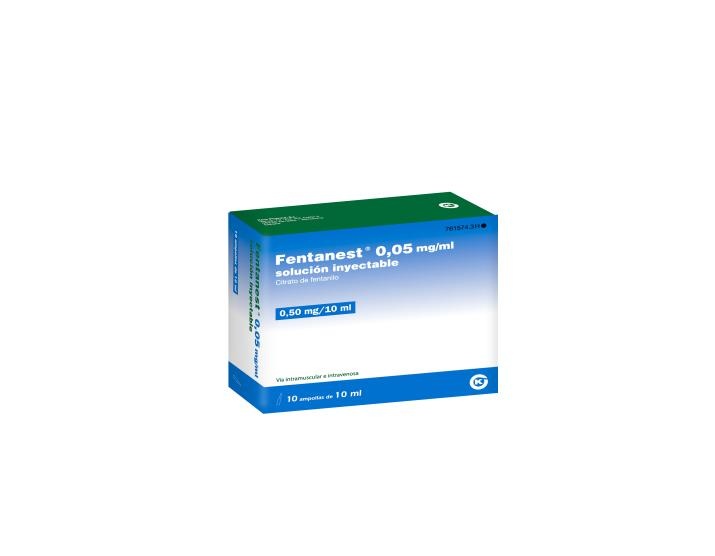

ФЕНТАНЕСТ 0,05 мг/мл ІН'ЄКЦІЙНИЙ РОЗЧИН

Запитайте лікаря про рецепт на ФЕНТАНЕСТ 0,05 мг/мл ІН'ЄКЦІЙНИЙ РОЗЧИН

Інструкція із застосування ФЕНТАНЕСТ 0,05 мг/мл ІН'ЄКЦІЙНИЙ РОЗЧИН
Вступ
Опис: Інформація для пацієнта
Фентанест 0,05 мг/мл розчин для ін'єкцій
Цитрат фентанілу
Прочитайте уважно весь опис перед тим, як почати використовувати цей препарат, оскільки він містить важливу інформацію для вас.
|
Зміст опису:
- Що таке Фентанест і для чого він використовується
- Що вам потрібно знати перед тим, як почати використовувати Фентанест
- Як використовувати Фентанест розчин для ін'єкцій
- Можливі побічні ефекти
- Збереження Фентанесту
- Зміст упаковки та додаткова інформація
1. Що таке Фентанест і для чого він використовується
Фентанест містить фентаніл як активну речовину. Це потужний препарат для зняття болю, який належить до групи наркотичних анальгетиків або опіоїдів.
Фентанест використовується:
- У загальній або місцевій анестезії як наркотичний анальгетик-допоміжний засіб.
- Як анальгетик перед операцією для допомоги в індукції та підтримці загальної та місцевої анестезії, при застосуванні разом з якимось нейролептиком (препаратом, який викликає седацію нервової системи), наприклад дроперидолом.
- Як анестетик з киснем у пацієнтів з високим ризиком під час хірургічних втручань.
2. Що вам потрібно знати перед тим, як почати використовувати Фентанест
Не використовуйте Фентанест
- Якщо ви алергічні на фентаніл або на будь-який інший компонент цього препарату (перелічені в розділі 6).
- Якщо у вас є відомі порушення толерантності до цього препарату або до інших морфіномімітиків (препаратів, які мають подібну дію до морфіну).
- Якщо у вас є травма головного мозку, підвищення внутрішньої черепної тиску або кома.
- Якщо пацієнт молодший 2 років.
Попередження та застереження
Проконсультуйтеся з вашим лікарем, фармацевтом або медсестрою перед тим, як почати використовувати Фентанест, якщо:
Ви або хтось з вашої сім'ї раніше мав проблеми з алкоголем, рецептурними препаратами або незаконними наркотиками ("депенденція").
- Ви курите.
- У вас раніше були проблеми з настроєм (депресія, тривога або розлад особистості) або якщо ви були-treated психіатром за іншу психічну хворобу.
Як і з іншими потужними опіоїдами, депресія дихання(повільне або слабке дихання, яке не може забезпечити адекватну вентиляцію та перфузію легень) залежить від дози і може бути усунено за допомогою антагоніста наркотиків (наприклад, налоксону). Однак може знадобитися введення додаткових доз цього антагоніста, оскільки депресія дихання може тривати довше, ніж дія опіоїдного антагоніста. Глибока анальгезія супроводжується вираженою депресією дихання, яка може зберігатися або повторюватися під час післяопераційного періоду. Через це пацієнти повинні перебувати під адекватним спостереженням. Поблизу повинні бути апарати штучної вентиляції легень та препарати-антагоністи наркотиків. Гіпервентіляція (швидке та глибоке дихання) під час анестезії може змінити реакцію пацієнта на вуглекислий газ, впливаючи на дихання в післяопераційному періоді.
Може виникнути м'язова ригідність, включаючи ригідність м'язів грудної клітки, яку можна уникнути шляхом повільного внутрішньовенного введення (що зазвичай достатньо для низьких доз), передопераційної підготовки з бензодіазепінами та введення м'язових релаксантів.
Можуть виникнути міоклонічні рухи(різкі та неконтрольовані рухи).
Якщо пацієнт не отримує достатньої кількості антиколінергійного препарату (препарату, який заспокоює м'язові спазми кишечника), або коли фентаніл застосовується разом з неміотропним м'язовим релаксантом, може виникнути брадикардія(зниження частоти серцевих скорочень), а навіть серцевий арест. Брадикардія можна лікувати шляхом введення атропіну.
Опіоїди можуть викликати низький артеріальний тиск, особливо у пацієнтів з значним зниженням нормального об'єму крові (гіповолемією). Необхідно застосовувати заходи для підтримання стабільного артеріального тиску.
Слід уникати застосування швидкого болюсного введення опіоїдів у пацієнтів з порушеною функцією головного мозку; тимчасове зниження середнього артеріального тиску інколи супроводжувалося тимчасовим зниженням перфузії головного мозку в цих пацієнтів.
Якщо лікування перервано, можуть виникнути симптоми абстиненції. Повідомте вашому лікареві або медсестрі, якщо ви вважаєте, що це відбувається з вами (див. також розділ 4. Можливі побічні ефекти).
Депенденція та абстиненція
Цей препарат містить фентаніл, який є опіоїдом. Він може викликати депенденцію та/або абстиненцію. |
Повторне застосування опіоїдних анальгетиків може привести до того, що препарат втрачає свою ефективність (хто його приймає, звикає до нього). Також може виникнути депенденція та абстиненція, що може привести до потенційно смертельної передозування. Якщо вас турбує можливість виникнення депенденції до Фентанесту, зверніться до вашого лікаря.
Особливо повідомте вашому лікареві або фармацевту, якщо ви приймаєте:
- Деякі анальгетики для лікування невропатичного болю (габапентин та прегабалін).
Пацієнти, які проходять тривале лікування опіоїдами або мають історію депенденції до опіоїдів, можуть потребувати вищої дози.
Рекомендується зменшити дозу у пацієнтів похилого віку та тих, хто має порушення здоров'я. Необхідно обережно регулювати дозу цього препарату у пацієнтів з такими порушеннями, як гіпотиреоз (зниження рівня тиреоїдних гормонів), захворювання легень, депресія дихання, алкоголізм, порушення функції нирок або печінки. Ці пацієнти також потребують тривалого післяопераційного спостереження.
При одночасному застосуванні фентанілу та дроперидолу лікар повинен знати характеристики кожного препарату, особливо різницю в тривалості дії. Одночасне застосування цих препаратів збільшує можливість низького артеріального тиску. Дроперидол може викликати неконтрольовані рухи тіла чи обличчя, які можна контролювати препаратами проти хвороби Паркінсона.
Застосування Фентанесту з іншими препаратами
Повідомте вашому лікареві або фармацевту, якщо ви приймаєте або приймали нещодавно чи можете приймати інші препарати.
Слід уникати одночасного застосування похідних барбітуратівз фентанілом, оскільки вони можуть посилити депресивну дію фентанілу на дихання.
Не рекомендується одночасне застосування фентанілу з бупренорфінами, налбуфінами або пентазоцином(препаратами, призначеними для лікування болю), оскільки вони можуть викликати симптоми абстиненції у пацієнтів, залежних від опіоїдів.
Одночасне застосування Фентанесту з препаратами, які сповільнюють діяльність центральної нервової системи (інші депресори центральної нервової системи), може призвести до адитивних депресивних ефектів, гіповентіляції та гіпотензії, а також глибокої седації чи коми. Депресори центральної нервової системи включають:
- опіоїди,
- антипсихотики,
- гіпнотики,
- загальні анестетики,
- м'язові релаксанти,
- седативні антигістаміни,
- алкогольні напої.
Адреналін не повинен застосовуватися як вазоактивний агент з фентанілом, оскільки це може привести до гіпотензії.
Отже, одночасне застосування будь-яких з цих препаратів та речовин вимагає спостереження за пацієнтом.
Було повідомлено, що інгібітори МАО(певна група антидепресивних препаратів) посилюють дію наркотичних анальгетиків, особливо у пацієнтів з серцевою недостатністю. Через це фентаніл не повинен застосовуватися протягом 14 днів після припинення лікування цими препаратами. Зазвичай рекомендується припиняти застосування інгібіторів МАО за дві тижні до будь-якої хірургічної операції. Однак декілька повідомлень описують застосування фентанілу під час хірургічних операцій у пацієнтів, які приймають інгібітори МАО, без виникнення взаємодії.
Одночасне застосування потужних інгібіторів CYP3A4, наприклад ритонавіру, кетоконазолу, ітраконазолу, макролідних антибіотиків, з фентанілом може привести до збільшення концентрації фентанілу в плазмі, що може посилити як терапевтичні, так і побічні ефекти та викликати важку депресію дихання. У цій ситуації необхідне особливе спостереження за пацієнтом. Не рекомендується одночасне застосування ритонавіру або інших потужних інгібіторів CYP3A4 з фентанілом, якщо тільки пацієнт не перебуває під постійним спостереженням.
Одночасне застосування фентанілу та седативних препаратів, таких як бензодіазепіни чи пов'язані з ними препарати, збільшує ризик сонливості, труднощів з диханням (депресія дихання), коми та може бути смертельним. Через це одночасне застосування повинно розглядатися лише тоді, коли інші варіанти лікування неможливі.
Однак якщо ваш лікар призначає фентаніл разом з седативними препаратами, доза та тривалість лікування повинні бути обмежені вашим лікарем.
Повідомте вашому лікареві про всі седативні препарати, які ви приймаєте, та слідуйте точно рекомендаціям вашого лікаря щодо дози. Можливо, буде корисно повідомити друзям або членам сім'ї, щоб вони були обізнані про вище згадані симптоми. Зверніться до вашого лікаря, якщо ви відчуваєте такі симптоми.
Вагітність, лактація та фертильність
Якщо ви вагітні або перебуваєте в період лактації, чи вважаєте, що можете бути вагітні чи маєте намір завагітніти, проконсультуйтеся з вашим лікарем або фармацевтом перед тим, як використовувати цей препарат.
Безпека застосування фентанілу під час вагітності не встановлена. Фентаніл не повинен застосовуватися під час вагітності, якщо тільки це не абсолютно необхідно. Тривале застосування під час вагітності може викликати синдром абстиненції у новонародженого.
Не рекомендується застосування фентанілу під час пологів (включаючи кесарів розтин) оскільки фентаніл проникає через плаценту та може викликати депресію дихання у новонародженого.
Фентаніл виділяється в грудне молоко та може викликати седацію та депресію дихання у новонародженого. Через це не рекомендується грудне вигодовування протягом 24 годин після застосування препарату.
Відповідальність за транспорт та використання машин
Не керуйте транспортними засобами чи не використовуйте інструменти чи машини після прийому Фентанесту, оскільки цей препарат може впливати на вашу реакцію. Ваш лікар вкаже, як довго вам потрібно чекати перед тим, як знову сідати за кермо чи використовувати машини.
Попередження про допінг
Спортсменам повідомляється, що цей препарат містить компонент, який може давати позитивний результат у тесті на допінг.
Фентанест містить натрій
Цей препарат містить менше 23 мг натрію (1 ммоль) на ампулу об'ємом 2, 3 та 5 мл; тобто, він практично "не містить натрію".
Цей препарат містить 35,4 мг натрію (основний компонент кухонної солі) в кожній ампулі об'ємом 10 мл. Це відповідає 1,81% від максимальної добової норми споживання натрію, рекомендованої для дорослих.
3. Як використовувати Фентанест
Дозування
Цей препарат повинен застосовуватися лікарем або медсестрою. Ваш лікар визначить найвідповіднішу дозу для вас залежно від вашого віку, ваги, загального стану здоров'я, типу операції та застосування інших препаратів.
Пацієнти похилого віку та ті, хто має порушення здоров'я
Доза, яка застосовується пацієнтам похилого віку (65 років та старше) або тим, хто має порушення здоров'я, прямо перед операцією, менша, ніж вказана для інших дорослих. Якщо лікар вважає це необхідним, може бути призначена додаткова доза пізніше.
Діти віком 2 роки та старше
Доза, яка застосовується дітям прямо перед операцією, залежить від ваги дитини. Якщо лікар вважає це необхідним, може бути призначена додаткова доза пізніше.
Підлітки віком 12-17 років отримують таку ж дозу, як і дорослі.
Діти віком менше 2 років
Немає досвіду застосування цього препарату у дітей віком менше 2 років. Через це не рекомендується застосовувати цей препарат у цій віковій групі.
Пацієнти з порушеннями нирок
Лікар може вирішити зменшити дозу, яку застосовується пацієнтам з порушеннями нирок.
Пацієнти з ожирінням
Доза, яка застосовується пацієнтам з ожирінням прямо перед операцією, може бути меншою, ніж вказана для інших дорослих. Якщо лікар вважає це необхідним, може бути призначена додаткова доза пізніше.
Шлях введення
Цей препарат може застосовуватися вену чи м'яз.
Якщо вам введено більше Фентанесту, ніж потрібно
Оскільки застосування цього препарату здійснюється в лікарні та здійснюється лікарем, малоймовірно, що вам буде введено надмірну кількість. Однак проконсультуйтеся з вашим лікарем або медсестрою, якщо ви вважаєте, що вам було введено надмірну кількість препарату чи якщо ви починаєте відчувати труднощі з диханням, головокружіння чи симптоми низького артеріального тиску чи м'язової ригідності. Передозування також може викликати порушення мозкової діяльності (відоме як токсична лейкоенцефалопатія).
Якщо у вас є якісь інші питання щодо застосування цього препарату, зверніться до вашого лікаря або медсестри.
4. Можливі побічні ефекти
Як і всі препарати, цей препарат може викликати побічні ефекти, хоча не всі люди їх відчувають.
Дуже часті(можуть виникнути у більш ніж 1 з 10 осіб):
- Сонливість.
- Головний біль, головокружіння.
- Нудота, блювота, запор.
- Потіння, свербіж.
Часті(можуть виникнути у до 1 з 10 осіб):
- Седація, нервозність, втрата апетиту, депресія.
- Сухість у роті (ксеростомія), дискомфорт у верхній частині живота (диспепсія).
- Реакції шкіри в місці застосування.
Менш часті(можуть виникнути у до 1 з 100 осіб):
- Ейфорія, амнезія, безсоння, галюцинації, агітація.
- Тремор, відчуття оніміння (парестезія), порушення мови, м'язова ригідність, міоклонус (мізові рухи, які є швидкими та неконтрольованими).
- Тахікардія, брадикардія.
- Гіпертонія, гіпотонія.
- Диспное (задишка), гіповентіляція.
- Діарея.
- Акуті шкіряні висипи (ексантема), червоність шкіри (еритема).
- Затримка сечі.
- Труднощі з ковтанням.
Рідкі(можуть виникнути у до 1 з 1000 осіб):
- Аритмія.
- Дилатація кровоносних судин.
- Ікота.
- Едема (набухання), відчуття холоду.
Дуже рідкі(можуть виникнути у до 1 з 10 000 осіб):
- Важка алергічна реакція усього тіла (анafilактична реакція).
- Деліріум (симптоми можуть включати комбінацію агітації, неспокою, дезорієнтації, конфузії, страху, бачення чи чуття речей, які насправді не існують, порушення сну, кошмари).
- Торпіння чи втрата координації (атаксія), конвульсії (включаючи клонічні та тоніко-клонічні конвульсії).
- Зниження зору в одному чи обох очах (амбліопія)
- Депресія дихання, апное.
- Вітряна коліка з болем, кишкова непрохідність.
- Боль у сечовому міхурі (цисталгія), зниження виділення сечі (олігурія).
Частота невідома(не можуть бути оцінені на основі наявних даних):
- Розвиток толерантності та фізичної та психологічної залежності при тривалому застосуванні фентанілу.
- Деліріум (симптоми можуть включати комбінацію агітації, неспокою, дезорієнтації, конфузії, страху, бачення чи чуття речей, які насправді не існують, порушення сну, кошмари).
- Симптоми абстиненції (можуть проявлятися у вигляді появи наступних побічних ефектів: нудота, блювота, діарея, тривога, озноб, тремор та потіння).
Депресія дихання є найважчим ефектом фентанілу.
Інші побічні ефекти:
Ларингоспазм.
Після застосування фентанілу з іншим нейролептиком, таким як дроперидол, можуть виникнути наступні побічні ефекти: тремор, нервозність, постопераційні галюцинації та екстрапірамідні симптоми.
Повідомлення про побічні ефекти
Якщо ви відчуваєте будь-який побічний ефект, проконсультуйтеся з вашим лікарем або фармацевтом, навіть якщо це побічні ефекти, які не наведені в цьому описі. Ви також можете повідомити про них безпосередньо через Систему моніторингу безпеки лікарських засобів для людини: https://www.notificaram.es/. Повідомляючи про побічні ефекти, ви можете допомогти надати більше інформації про безпеку цього препарату.
5. Збереження Фентанесту
Тримайте поза досяжністю дітей.
Не вимагає особливих умов зберігання. Зберігайте в оригінальній упаковці для захисту від світла. Використовуйте негайно після відкриття.
Не використовуйте цей препарат після закінчення терміну придатності, вказаного на упаковці після "CAD". Термін придатності - останній день місяця, який вказано.
Лікарські засоби не повинні викидатися у каналізацію чи сміттєві контейнери. Виведення незастосованого препарату та всіх матеріалів, які були в контакті з ним, повинно здійснюватися згідно з місцевими правилами. Таким чином ви допоможете захистити навколишнє середовище.
6. Зміст упаковки та додаткова інформація
Склад Фентанесту
- Активний інгредієнт - фентаніл. Кожен мл розчину містить 0,0785 мг цитрату фентанілу, що еквівалентно 0,05 мг фентанілу.
Кожна ампула по 2 мл містить 0,157 мг цитрату фентанілу, що еквівалентно 0,1 мг фентанілу.
Кожна ампула по 3 мл містить 0,2355 мг цитрату фентанілу, що еквівалентно 0,15 мг фентанілу.
Кожна ампула по 5 мл містить 0,3925 мг цитрату фентанілу, що еквівалентно 0,25 мг фентанілу.
Кожна ампула по 10 мл містить 0,785 мг цитрату фентанілу, що еквівалентно 0,5 мг фентанілу.
- Інші компоненти - хлорид натрію та вода для ін'єкцій.
Вигляд продукту та вміст упаковки
Коробки по 10 ампул по 2 мл, 5 ампул по 3 мл, 10 ампул по 3 мл, 10 ампул по 5 мл або 10 ампул по 10 мл.
Можливо, що будуть продаватися лише деякі розміри упаковки.
Ампули прозорі та містять прозорий та безбарвний ліків.
Уповноважений на отримання дозволу на продаж та відповідальний за виробництво
Kern Pharma, S.L.
Venus, 72 - Pol. Ind. Colón II
08228 Terrassa - Barcelona
Іспанія
Дата останнього перегляду цього проспекту: Березень 2025
Детальна та актуальна інформація про цей лікарський засіб доступна на сайті Іспанського агентства з лікарських засобів та медичних продуктів (AEMPS) http://www.aemps.gob.es/
Ця інформація призначена лише для фахівців у сфері охорони здоров'я:
Перегляньте технічну характеристику або резюме продукту, щоб отримати повну опис та іншу інформацію.
Дозування та спосіб застосування
Цей лікарський засіб повинен застосовуватися лише в середовищі, де можливо контролювати дихальні шляхи, та лише фахівцями, які можуть спостерігати за дихальними шляхами (див. Технічна характеристика, розділ 4.4).
Дозування цього лікарського засобу повинно визначатися індивідуально залежно від віку, маси тіла, фізичного стану, основного захворювання, використання інших лікарських засобів та типу хірургічної операції та анестезії.
Дорослі
Премедикація
Як премедикація (за 30-60 хвилин до операції) звичайна доза становить 0,7-1,4 мкг/кг (0,014-0,028 мл/кг) Фентанесту внутрішньом'язово або внутрішньовенно повільно.
Застосування як додатковий анальгетик до місцевої анестезії
Фентанест можна застосовувати як додатковий анальгетик до місцевої анестезії у дозах від 0,35 до 1,4 мкг/кг (0,007-0,028 мл/кг) внутрішньом'язово або внутрішньовенно.
Застосування як додатковий анальгетик до загальної анестезії
Низькі дози: 2 мкг/кг (0,04 мл/кг)
Фентаніл у низьких дозах дуже корисний під час менших, але болісних хірургічних операцій.
Середні дози: 2-20 мкг/кг (0,04-0,4 мл/кг)
Коли хірургічна операція більш складна, необхідно застосовувати середню дозу.
Тривалість дії залежить від дози.
Високі дози: 20-50 мкг/кг (0,4-1 мл/кг)
Під час великих хірургічних операцій, які тривають довше, застосування доз 20-50 мкг/кг (0,4-1 мл/кг) фентанілу з протоксидом азоту/оксигену показало загальмовуючу дію.
Ваш лікар проведе вентиляцію та спостереження після операції.
Інкременти по 25-250 мкг/кг (0,5-5 мл) можуть бути застосовані залежно від потреб пацієнта та тривалості операції.
Застосування як анестетик
Коли особливо важливо зменшити реакцію на хірургічний стимул, можуть бути застосовані дози 50-100 мкг/кг (1-2 мл/кг) внутрішньовенно з оксигеном та м'язовим релаксантом. Ця техніка забезпечує анестезію без додаткового застосування анестетиків.
У деяких випадках може бути необхідне застосування доз до 150 мкг/кг (3 мл/кг) для досягнення анестетичного ефекту.
Фентаніл був застосований під час операцій на відкритому серці та деяких великих хірургічних операцій у пацієнтів, яким особливо показана захист серця від надмірного оксигену.
Застосування у пацієнтів похилого віку та ослаблених
Як і з іншими опіоїдами, доза, що застосовується у пацієнтів похилого віку або ослаблених, повинна бути зменшена.
Застосування у дітей
Для індукції та підтримки анестезії у дітей від 2 до 12 років рекомендується зменшити дозу до 2-3 мкг/кг (0,04-0,06 мл/кг).
Застосування у пацієнтів з нирковою недостатністю
Дані, отримані з дослідження, у якому фентаніл був застосований внутрішньовенно у пацієнтів, які піддавалися трансплантації нирки, свідчать про те, що видалення фентанілу може бути зменшено у популяції пацієнтів. Якщо пацієнти з нирковою недостатністю отримують фентаніл, їх необхідно спостерігати з особливою увагою на предмет ознак токсичності фентанілу та зменшувати дозу у разі необхідності (див. Дозування та застосування).
Пацієнти з ожирінням
У пацієнтів з ожирінням існує ризик передозування, якщо доза розрахована на основі маси тіла. Дозу для пацієнтів з ожирінням необхідно розрахувати на основі м'язової маси тіла, а не лише на основі маси тіла.
Спецальні попередження та обережність при застосуванні
Як і з іншими сильними опіоїдами:
Респіраторна депресія залежить від дози та може бути усунена застосуванням наркотичного антагоніста (налоксону), але можливо буде необхідно застосувати додаткові дози цього антагоніста, оскільки респіраторна депресія може мати більшу тривалість дії, ніж опіоїдні антагоністи. Глибока анальгезія супроводжується вираженою респіраторною депресією, яка може тривати або повторюватися у післяопераційному періоді. Тому пацієнтів необхідно піддавати відповідному спостереженню. Необхідно мати апарат для реанімації та наркотичні антагоністи.
Гіпервентіляція під час анестезії може змінити реакцію пацієнта на СО2, що впливає на дихання у післяопераційному періоді.
Може виникнути м'язова ригідність, включаючи ригідність м'язів грудної клітки, яку можна уникнути, якщо застосувати наступні заходи: внутрішньовенне введення повільно (що зазвичай достатньо для низьких доз), премедикація бензодіазепіном та застосування м'язових релаксантів.
Можуть виникнути рухові (міо)клонічні рухи, не пов'язані з епілепсією.
Може виникнути брадикардія та, можливо, асистолія, якщо пацієнт отримує недостатню кількість антихолінергічного засобу або якщо Фентанест застосовується у поєднанні з м'язовим релаксантом, який не є ваголітиком. Брадикардія може бути усунена застосуванням атропіну.
Опіоїди можуть викликати гіпотензію, особливо у пацієнтів з гіповолемією. Необхідно вживати заходів для підтримки стабільного артеріального тиску.
Необхідно уникати швидкого внутрішньовенного введення опіоїдів у пацієнтів з порушеннями дистенсібельності цереброваскулярної системи, оскільки тимчасове зниження середнього артеріального тиску інколи супроводжується тимчасовим зниженням церебрального кровотоку у цих пацієнтів.
Пацієнти, які отримують тривале лікування опіоїдами або мають історію зловживання опіоїдами, можуть потребувати більших доз.
Якщо Фентанест застосовується у поєднанні з дроперидолом, лікар повинен знати властивості кожного препарату, особливо різницю у тривалості дії. Частота гіпотензії збільшується при застосуванні цієї комбінації. Дроперидол може викликати екстрапірамідні симптоми, які можна контролювати антипаркінсонічними засобами.
Фармакологічна залежність та потенційний зловживання
Можуть розвиватися толерантність, фізична та психологічна залежність після повторного застосування опіоїдів. Ризики збільшуються у пацієнтів з особистою історією зловживання речовинами (включаючи зловживання або залежність від наркотиків чи алкоголю).
Синдром відміни
Повторне застосування з короткими інтервалами протягом тривалого періоду може привести до розвитку синдрому відміни після припинення лікування, який може проявлятися появою наступних побічних ефектів: нудота, блювота, діарея, тривога, озноб, тремор та потіння.
Інструкції з відкриття ампул
- Тримати ампулу між вказівним та великим пальцями з направленням кінчика ампули вгору.
- Утримувати кінчик ампули, помістивши вказівний палець іншої руки проти шиї ампули. Помістити великий палець для прикриття кінчика ампули, як показано на малюнку.
- З'єднаними вказівними пальцями натиснути на кінчик, щоб відкрити ампулу.

Несумісності
У відсутності досліджень сумісності цей лікарський засіб не повинен змішуватися з іншими.
Протипоказання
- Гіперчутливість до активного інгредієнту або до одного з допоміжних речовин, перелічених у розділі 6 технічної характеристики, або до інших опіоїдів.
- Респіраторна недостатність без механічної вентиляції через специфічний респіраторний депресивний ефект морфіноміметичних засобів.
- Країна реєстрації
- Доступність у аптекахПроблеми з постачанням
- Діючі речовини
- Потрібен рецептТак
- Виробник
- Інформація є довідковою і не є медичною порадою. Перед прийомом будь-яких препаратів обов'язково проконсультуйтеся з лікарем. Oladoctor не несе відповідальності за медичні рішення, прийняті на основі цього контенту.
- Альтернативи до ФЕНТАНЕСТ 0,05 мг/мл ІН'ЄКЦІЙНИЙ РОЗЧИНФорма випуску: РОЗЧИН ДЛЯ ІН'ЄКЦІЙ, 50 мікрограмівДіючі речовини: fentanylПотрібен рецептФорма випуску: РОЗЧИН ДЛЯ ІН'ЄКЦІЙ, 0,05 мг/млДіючі речовини: fentanylВиробник: Kalceks AsПотрібен рецептФорма випуску: СУБЛІНГВАЛЬНА ТАБЛЕТКА, 30 МІКРОГРАМДіючі речовини: sufentanilВиробник: Laboratoire AguettantПотрібен рецепт
Аналоги ФЕНТАНЕСТ 0,05 мг/мл ІН'ЄКЦІЙНИЙ РОЗЧИН в інших країнах
Найкращі аналоги з тією самою діючою речовиною та терапевтичним ефектом.
Аналог ФЕНТАНЕСТ 0,05 мг/мл ІН'ЄКЦІЙНИЙ РОЗЧИН у Польща
Аналог ФЕНТАНЕСТ 0,05 мг/мл ІН'ЄКЦІЙНИЙ РОЗЧИН у Україна
Лікарі онлайн щодо ФЕНТАНЕСТ 0,05 мг/мл ІН'ЄКЦІЙНИЙ РОЗЧИН
Консультація щодо дозування, побічних ефектів, взаємодій, протипоказань та поновлення рецепта на ФЕНТАНЕСТ 0,05 мг/мл ІН'ЄКЦІЙНИЙ РОЗЧИН – за рішенням лікаря та згідно з місцевими правилами.














